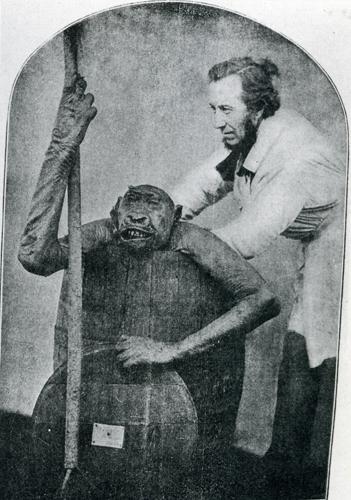
December 2, 2007

The great taxidermist Araham Dee Bartlett is shown with his first gorilla, collected by Mr. Du Challu for Professor Owen, British National Museum, circa 1855. The wave of interest in the discovery of the lowland, and then the mountain gorilla caused this species to be a point of reference for many “creature” reports in America during the early 20th century.
Sometimes we have to read through the ugliest forms of racism that existed in American journalism in the 1930s to extract the essence of possible cryptozoological eyewitness evidence existing in old news articles.
Please be forewarned that descriptions in these two separate articles may offend some readers, but they are shared, as is, to keep intact the elements of the material that might be lost through extensive editing.
Distant Relative Of Mobile’s Monster Reported
ROCKHILL [sic], S.C., Feb. 5 (UP). “The Monster of Marmotte Street” which has terrorized the negro population of Mobile, Ala., was reported tonight [Saturday evening] to have a distant relative operating among the dusky folk of Rockhill.
The mysterious beast here was called the “African Udilacus,” said to resemble a gorilla.
Two frightened negro men told police that a fierce, fur-covered animal accosted them on a lonely, dimly-lit street last night. Another negro reported that the beast had attacked him and ripped off his clothing before he managed to escape its “awful” clutch.
Police, who were without a theory as to the identity of the weird animal, also received a report that the African Udilacus had killed a large calf on the edge of this small South Carolina town and eaten away much of the caucus [sic = carcass?].
A check was made at a circus wintering near here, but they reported all their animals present and accounted for in their cages.
Police at Mobile, Ala., after spending a hectic week investigating fantastic reports in the colored district, decided the “Monster of Marmotte Street” had slunk back to the swamp bordering the colored residential district.
The Mobile monster was described in various ways – all horrible. Police never were able to secure more tangible evidence concerning the beasts other than wild rumors. The same situation existed in Rockhill.
The Udilacus was first reported in a cotton mill section on the outskirts of Rockhill.
John White, a “dark town” resident, furnished the details:
“It was standing in the water. It was black and tall as a man. I threw a rock at it but it snarled and started after me.
“I ran.”
Bruce Neal, who was with White when the Udilacus appeared, said the animal ran on two legs as it chased them.
“After it chased us a little way, it dropped down on all fours,” Neal explained.
Neal also said the monster “smelled terrible.”Delta Star, Greenville, Mississippi, Sunday, February 6, 1938.
Jerome Clark adds this comment, as he passes this along:
“Rockhill” is actually spelled Rock Hill. (I was there for about a week some 20 years ago.) One wonders if “African Udilacus”– a phrase nowhere used in any actual witness quote — was in truth the reporter’s invention, a racist, ridicule-laced attempt at the sort of “darky” humor that for so long vastly amused the white folks of the Deep South. ~ J. Clark.
There is another article about the “Udilacus” that I located online. Michael Goodspeed shared the following in 2004, making the point that Bigfoot-like reports have been around a long time.
Shambling Beast Terrorizes Town
Hairy Animal Reported In South Carolina Village
Rock Hill, S.C., Feb. 7 — Reports of a huge, hairy beast called the “African udilacus” continued to spread terror among negro residents of this South Carolina town Sunday [February 6, 1938].
Constable Carl Hovis reported he saw the shambling beast in a dark back alley and shot at it twice but failed to bring it down.
Sam Watts, negro, said he was chased through a wooded area by the “varmint,” which made “grunting noises.”
Police reported the mysterious monster has a particular aversion to dogs. Two were found dead, apparently from strangulation, and a dozen were reported bitten, beaten and scratched in the Willow Brook section of town. The Daily Gleaner, Wednesday, February 9, 1938.
About Loren Coleman
Loren Coleman is one of the world’s leading cryptozoologists, some say “the” leading living cryptozoologist. Certainly, he is acknowledged as the current living American researcher and writer who has most popularized cryptozoology in the late 20th and early 21st centuries.
Starting his fieldwork and investigations in 1960, after traveling and trekking extensively in pursuit of cryptozoological mysteries, Coleman began writing to share his experiences in 1969. An honorary member of Ivan T. Sanderson’s Society for the Investigation of the Unexplained in the 1970s, Coleman has been bestowed with similar honorary memberships of the North Idaho College Cryptozoology Club in 1983, and in subsequent years, that of the British Columbia Scientific Cryptozoology Club, CryptoSafari International, and other international organizations. He was also a Life Member and Benefactor of the International Society of Cryptozoology (now-defunct).
Loren Coleman’s daily blog, as a member of the Cryptomundo Team, served as an ongoing avenue of communication for the ever-growing body of cryptozoo news from 2005 through 2013. He returned as an infrequent contributor beginning Halloween week of 2015.
Coleman is the founder in 2003, and current director of the International Cryptozoology Museum in Portland, Maine.
Filed under Bigfoot, Cryptomundo Exclusive, Cryptotourism, CryptoZoo News, Cryptozoologists, Cryptozoology, Eyewitness Accounts, Swamp Monsters, Windigo